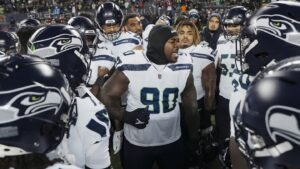Take a look at some answers to frequently asked questions about the United States Open:
How old is the U.S. Open?
It is 130 years old. The first one was played in 1895.
How many times has the U.S. Open been played?
This year will mark the 125th U.S. Open. It was not played in 1917 or 1918 because of World War I, nor was it played in 1942-45 because of World War II.
Who started the U.S. Open?
The United States Golf Association, an organization formed in 1894 by five prominent golf clubs to be the game’s national governing body.
Is the U.S. Open the oldest national championship in the world?
No. The Open, also referred to as The Open Championship, dates back to 1860.
Where was the first U.S. Open played?
It was played on a nine-hole course at Newport (R.I.) Country Club.
Who was the first U.S. Open winner?
Horace Rawlins, a 21-year-old Englishman, shot 173 for 36 holes to beat Scotsman Willie Dunn by two strokes.
Who is the most recent U.S. Open winner?
Bryson DeChambeau. He earned his second U.S. Open title (2020) by getting up and down from a greenside bunker to save par and finish one shot clear of Rory McIlroy at Pinehurst No. 2.
Who has won the most U.S. Opens?
Four players have won the U.S. Open four times each: Scotsman Willie Anderson and Americans Bobby Jones, Ben Hogan and Jack Nicklaus. Hogan also won the 1942 Hale America Open, which some of his supporters claim should be counted as his fifth U.S. Open. The Hale America was a substitute for the U.S. Open, was held in the same time slot and was run like the U.S. Open with local and final qualifying.
How many times has a player won consecutive U.S. Opens?
Six players have won back-to-back Opens and one has won three in a row. Chronologically, they are Scotsman Willie Anderson (1903-05), and Americans John McDermott (1911-12), Bobby Jones (1929-30), Ralph Guldahl (1937-38), Ben Hogan (1950-51), Curtis Strange (1988-89) and Brooks Koepka (2018-19).
Who are the most noteworthy players who have NOT won a U.S. Open?
This list would have to start with Sam Snead, whose failure to win a U.S. Open cost him a career Grand Slam. Snead was runner-up in the Open four times – in 1937, 1947, 1949 and 1953. But his most painful loss probably came in 1939, when he came to the final hole needing only a par to win but instead made a triple bogey. As on-course scoreboards did not yet exist, Snead didn’t know he needed only a par; a spectator erroneously told him he needed a birdie. Phil Mickelson is also in this category; he has a record six runner-up finishes (1999, 2002, 2004, 2006, 2009, 2013) and a U.S. Open win would also earn him the career Grand Slam.
Where is this year’s U.S. Open?
Oakmont Country Club in Oakmont, Pennsylvania. It will be a record 10th time that the course has played host to the U.S. Open. The most recent occasion was 2016, when Dustin Johnson prevailed. Other past winners include Angel Cabrera (2007), Ernie Els (1994), Larry Nelson (1983), Johnny Miller (1973), Jack Nicklaus (1962), Ben Hogan (1953), Sam Parks, Jr. (1935) and Tommy Armour (1927).
Which U.S. Opens have been the most memorable?
It’s all a matter of opinion, of course. Working backwards in the top 10:
- 10. 1973: Johnny Miller shoots a record 63 in the final round to win.
- 9. 1982: Tom Watson chips in from deep rough on the 71st hole to win at Pebble Beach.
- 8. 2008: Limping on what would turn out to be a broken leg, Tiger Woods edges Rocco Mediate after an 18-hole playoff and one sudden-death hole.
- 7. 1930: Bobby Jones wins the third leg of a Grand Slam he would soon complete.
- 6. 2000: Woods destroys the field by a record 15 shots at Pebble Beach.
- 5. 1950: Less than a year and a half after a near-fatal car accident, Ben Hogan wins at Merion.
- 4. 1966: Seven shots ahead of playing partner Billy Casper at the final turn, Arnold Palmer is caught and loses in an 18-hole playoff.
- 3: 1913: Francis Ouimet stuns the golf world.
- 2. 1962: Rookie Jack Nicklaus takes it to Palmer in front of Arnie’s home crowd at Oakmont.
- 1. 1960: Seven shots back after 54 holes, Palmer drives the green on the first hole, a par 4, shoots 65 and wins his first – and only – U.S. Open.
How do you get to play in a U.S. Open?
Below are the 2025 exemption categories, per the USGA. Anyone — with a Handicap Index not exceeding 0.4 — however, can earn a spot in the field through 18-hole local and 36-hole final qualifying. Certain players are exempt into the latter stage, with most players having to go through both. There were 110 local and 13 final sites this year.
- F-1. Winners of the U.S. Open the last 10 years;
- F-2. From the 2024 U.S. Open, the 10 lowest scorers and anyone tying for 10th place;
- F-3. Winner of the 2024 U.S. Senior Open;
- F-4. Winner of the 2024 U.S. Amateur;
- F-5. Winners of the 2024 U.S. Junior Amateur and U.S. Mid-Amateur championships, and the 2024 U.S. Amateur runner-up (must be an amateur);
- F-6. Winners of the Masters Tournament, 2020-2025;
- F-7. Winners of the PGA Championship, 2021-2025;
- F-8. Winners of The Open, 2021-2024;
- F-9. Winners of The Players Championship 2023-2025;
- F-10. Winner of the 2024 DP World Tour BMW PGA Championship;
- F-11. Those players who qualified and were eligible for the season-ending 2024 Tour Championship;
- F-12. Multiple winners of PGA Tour events that award a full-point allocation for the FedExCup, from the conclusion of the 2024 U.S. Open (June 13-16) to the initiation of the 2025 U.S. Open;
- F-13. The Top 5 players in the 2025 FedExCup standings as of May 19, 2025, who are not otherwise exempt;
- F-14. The points leader from the 2024 Korn Ferry Tour season using combined points earned on the Official Korn Ferry Tour Regular Season Points Standings and points earned in the Korn Ferry Tour Finals;
- F-15. The top two players from the final 2024 Race to Dubai Rankings, who are not otherwise exempt as of May 19, 2025;
- F-16. The top player on the 2025 Race to Dubai Rankings as of May 19, 2025, who is not otherwise exempt;
- F-17. Winner of the 2024 Amateur Championship (must be an amateur);
- F-18. Winner of the 2024 Mark H. McCormack Medal (Men’s World Amateur Golf Ranking) (must be an amateur);
- F-19. Winner of the 2025 NCAA Division I Men’s Individual Golf Championship (must be an amateur);
- F-20. Winner of the 2025 Latin America Amateur Championship (must be an amateur);
- F-21. From the current Official World Golf Ranking, the top 60 points leaders and ties as of May 19, 2025;
- F-22. From the current Official World Golf Ranking, the top 60 points leaders and ties as of June 9, 2025;
- F.23. Winner of the 2024 Olympic gold medal, contested August 1-4, 2024;
- F.24. The top player who is not otherwise exempt and in the top 3 of the 2025 LIV Golf Individual Standings as of May 19, 2025;
- F-25. Special exemptions selected by the USGA. Deadline for submission of request: May 15, 2025.
Who is the oldest player to win the U.S. Open?
Hale Irwin was 45 years and 15 days old when he won in 1990.
Who was the youngest U.S. Open winner?
John McDermott was 19 years, 315 days old when he won in 1911.
Who was the youngest U.S. Open player?
In 2012 a 14-year-old amateur from China, Andy Zhang, qualified.
Who had the largest U.S. Open victory margin?
Tiger Woods won by 15 strokes in 2000. This is the record for any major.
Who holds the 72-hole U.S. Open scoring record?
Rory McIlroy shot 268 in 2011. That was 16 under par – also a record – on par-71 Congressional. Brooks Koepka won in 2017 at par-72 Erin Hills with a 16-under total (272).
Who holds the 18-hole aggregate U.S. Open scoring record?
This was long known as Johnny Miller’s record (even though others subsequently tied it). Miller famously closed in 63 to win the 1973 U.S. Open at Oakmont. In 2023, however, Rickie Fowler opened in 62 at LACC to establish a new aggregate record. A few minutes after he did that, Xander Schauffele posted a 62 as well. They now co-own the mark.
What does a player get for winning the U.S. Open?
Last year’s winner collected $4,300,000 (out of $21.5 million, overall purse). The winner is also exempt from qualifying for the other three majors and The Players Championship for the next five years, and exempt from U.S. Open qualifying for the next 10 years. If the winner is a PGA Tour member, he would receive a five-year exemption to all PGA Tour events.
What happens if the U.S. Open is tied after 72 holes?
There used to be an 18-hole playoff the following day. Now, if two or more players are tied at the end of regulation there is a two-hole aggregate playoff, followed by sudden death.
Read the full article here














